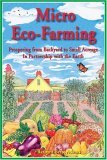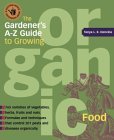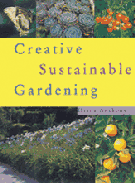
FREE Garden Journal!!
Join "Garden Notes" and plan for Harvest Success as you track and record your gardening progress. Your Free Personal Garden Journal has pages for jotting down notes on the seeds you start, your new plantings, when you fertilized, and even a graph to plot a new garden.
How To's | Technique | Practical Advice | Children | Internet Gardening | Vermicomposting | Pest Management


Helpful books on Sustainable Organic Gardening
Micro Eco-Farming: Prospering from Backyard to Small Acreage in Partnership with the Earth

There’s been lots of growth and excitement in the world of micro eco-farming since this title’s release.
The prestigious Leopold Center for Sustainable Agriculture has since declared two of the growing methods described in detail in this title: creating “living” soil and “no-till,” as top priority.
The method briefly introduced in the book for “treating” wild predators (a coyote in the case described in the book) with a method to get them to avoid certain livestock for their lifetimes has now been approved by authorities for use with the Mexican wolf. Longer versions of this story are being published in AcresUSA.
The farmer and researcher interviewed in this title who eliminated Canadian thistle and a multitude of crop and human diseases by going beyond organic was invited to present some of his findings at the Geneva Conference.
Mainstream entities, such as extension agents and national flower societies, now advise growers of a plants’ ability to attract its host pest when under stress, and so therefore, advise growers to keep their plants healthy as a means of pest control. This helps micro eco-farms from urban to rural locations, because more and more of their mainstream neighbors are also sustainable, and less likely to create pesticide or chemical drift onto the nearby micro eco-farms tucked into small parcels of land.
The use of plant “accumulators” as described in this book, which have taproots that mine missing trace minerals and bring them to the surface to take your crops’ health and yield beyond ordinary organics is now being taught in a variety of workshops for farmers, gardeners and homesteaders.
Bio-diesel production is causing even more demand for local food independence and more micro and small eco-farms, as land once used to grow food and fiber crops gives way to biomass for fuel.
Younger generations are now joining older ones in seeking livelihoods that contribute to the reversal of global warming.
Micro eco-farms are as far ranging as apartment renters raising angora rabbits to urban rooftop beekeepers to backyard flower farmers to owners of 1 to 20 rural acres. They’re very diverse and unique to their own communities and bio-regions, and there is not one national cookie cutter how-to (that’s why they flourish, because they are unique and adaptable). But there are some universal concepts that apply to all of them, as this title describes, such as leveraging one’s local community or shared interest groups, spotting unfilled niches, and seeking production techniques beyond organic (such as the addition of replacing the full spectrum of trace minerals.)
The Gardener's A-Z Guide to Growing Organic Food

Before it was a book, The Gardener's A-Z Guide to Growing Organic Food was organic gardener Tanya L. K. Denckla's highly prized personal database, the distillation of years of careful research and hands-on, real-life, dirt-under-the-fingernails experience in growing her own vegetables, herbs, fruits, and nuts. Now available to all, this easy-to-read sourcebook offers much to gardeners of all skill levels, answering questions quickly and authoritatively so more time can be spent enjoying the garden.
Six comprehensive chapters cover vegetables, fruits and nuts, herbs, organic remedies, and allies and companions. Within each chapter plants are arranged alphabetically, making needed information eminently accessible. Individual plant entries provide specific information on planting; temperature; soil and water needs; measurements; seed-starting dates; pests, diseases, allies, companions, and incompatibles, as applicable; when to harvest; how to store produce; and overviews of selected varieties.
Fully half of the book is dedicated to organic remedies that can prevent or combat plant diseases and garden pests. Hundreds of common diseases and pests are discussed, as well as which plants are likely to be affected, how to recognize the problem, and tried-and-true natural remedies. The Gardener's A-Z Guide to Growing Organic Food demystifies how to work collaboratively with the complex natural systems of the environment, making gardening a little easier and definitely more fun.
A book for all those gardeners wishing to improve their soil, crops and ornamental plants without harming the environment in the process. Full of practical advice and alternatives to toxic chemicals - with recipes for soil drenches, foliar feeds and natural pesticides. Includes chapters on what it means to garden sustainably; companion planting; benign pest, disease and weed control; no-soil gardening; drought resistant gardens; low maintenance gardens and landscaping with trees. Creative Sustainable Gardening is a comprehensive guide to healthy gardens and a healthy future for the wider environment. Illustrated in colour throughout with complementary quick reference tables in each chapter.
Search on
Sustainable Living:








